As a mediabuyer you’re faced with a lot of tools when creating a campaign. Some of them you may leave by default because its impact on campaign’s performance is almost invisible; but for others you should take a special consideration. One of them is the frequency capping, whether applied to a campaign, ad or spot.
The frequency capping is a tool that allows you to limit how often an ad is served to the same user by a given period of time. In other words, it refers to the maximum number of impressions the user will view each ad. If you set a frequency cap of 2/24 hours for an ad, it will be shown at maximum twice for the same user in only one day. If you choose this metric for a campaign and you have more than one banner implemented there, the frequency cap of 2/24 hours means that the user will see 2 impressions in 24 hours, independently of the banner, that is, the impressions can come from the same banner or from different banners, it will always depend on the ads rotation system inside the campaign (it can be random rotation, based on CTR or performance). In some cases, the frequency capping can also be applied to a zone or group of campaigns.
What’s the idea behind this tool? It is a very useful tool when you’re buying on a CPM basis (cost per one thousand impressions) and you’re receiving by conversion, lead or sale. As your main goal is leading the user to the conversion, you can restrict your costs by paying only for the impressions that are most likely to give you more revenues. If a user sees a banner many times and doesn’t click on it, you cannot expect it will do it in the near future and so you don’t need to pay for that impression forever.
The frequency capping you should set depends on your position among the competition. Let me clarify you with some examples.
You know that you’re not in the first positions, that there is another “guy” paying more than you for each impression for a given spot and/or campaign. You’re basically receiving the rest of the traffic he is not able to get or doesn’t want (case 1). What I would suggest you is to try to gain the top positions by raising your bid, and analyze if it is rentable for you or not.
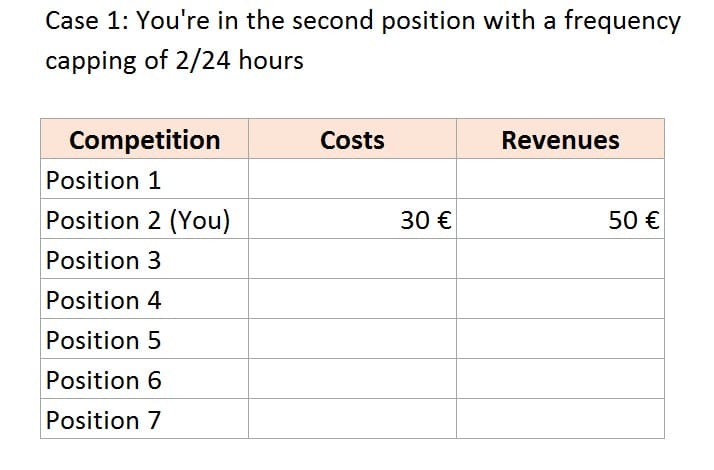
After you increase your bid, you can face one of these two scenarios: the first position is far away from being profitable for you (case 2) or it comes to be your perfect position (case 3).
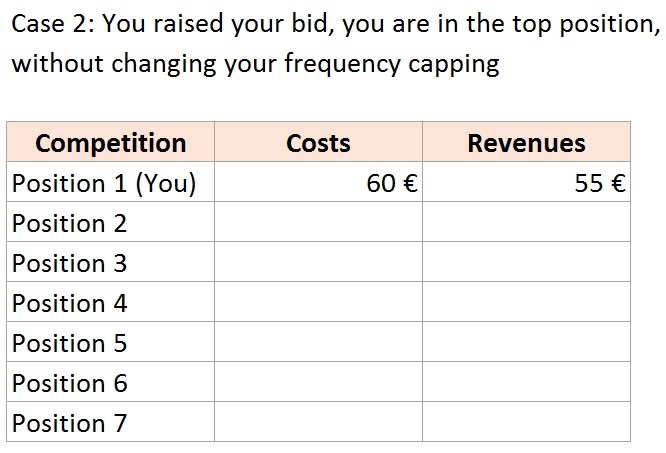
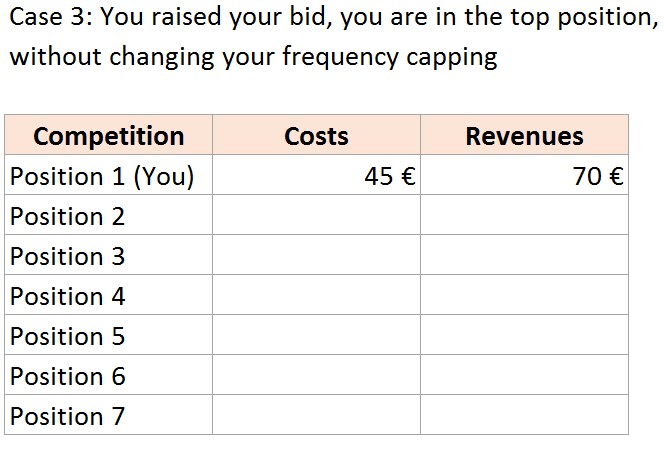
In the first scenario, and once you arrive to the first position you can expand your frequency capping or even disable it to bring more profitable impressions, until the point that is still rentable for you (case 4 and 5).
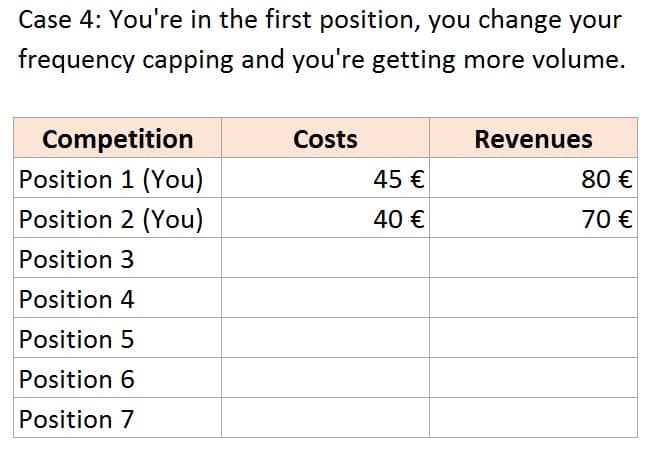

However, not always the first position is the perfect for a media buyer. Sometimes you can lose money there. In this case, and taking into account that you are gaining money in the second position, you can try to receive more volume in lower positions, and until reaching a point where it is not profitable (case 6).
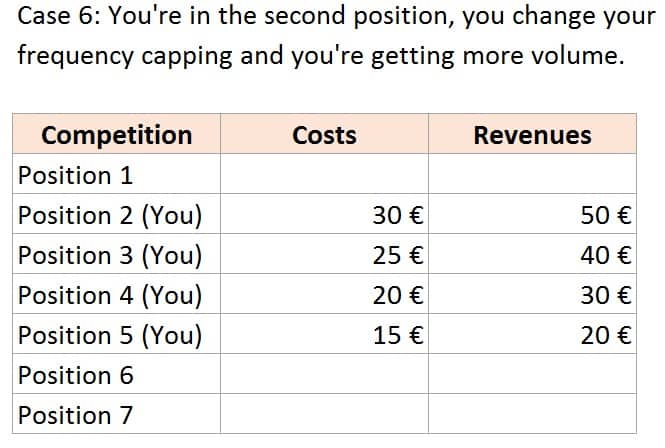
As the number of impressions increase, the CTR of the banners will decrease, that is,increasing the capping means decreasing the average quality of your traffic. For this reason, I would advise you not to consider the CTR and performance of the banners and/or campaign before the changes.
If you’re managing a new campaign and have no information regarding your position, I suggest you to try a low frequency cap, for example 1/24 hours or 2/24 hours and then analyze its performance. Try to make tests and measure the campaign’s performance with changes in the frequency capping and be surprised for whether a simple change can cause you damages or increase the profitable impressions.
To sum up, the changes in the frequency capping are crucial when you are trying to increase or limit your inventory. For example if you identify in your campaign a period of the day/week that performs better than others, you can increase the capping for that period to gain more impressions, that means work the Dayparting. I would also advise you to be careful with changes in the frequency capping as they only work when you’re in a profitable position; otherwise you’ll lose money.
The frequency capping is a tool that allows you to limit how often an ad is served to the same user by a given period of time. In other words, it refers to the maximum number of impressions the user will view each ad. If you set a frequency cap of 2/24 hours for an ad, it will be shown at maximum twice for the same user in only one day. If you choose this metric for a campaign and you have more than one banner implemented there, the frequency cap of 2/24 hours means that the user will see 2 impressions in 24 hours, independently of the banner, that is, the impressions can come from the same banner or from different banners, it will always depend on the ads rotation system inside the campaign (it can be random rotation, based on CTR or performance). In some cases, the frequency capping can also be applied to a zone or group of campaigns.
What’s the idea behind this tool? It is a very useful tool when you’re buying on a CPM basis (cost per one thousand impressions) and you’re receiving by conversion, lead or sale. As your main goal is leading the user to the conversion, you can restrict your costs by paying only for the impressions that are most likely to give you more revenues. If a user sees a banner many times and doesn’t click on it, you cannot expect it will do it in the near future and so you don’t need to pay for that impression forever.
The frequency capping you should set depends on your position among the competition. Let me clarify you with some examples.
You know that you’re not in the first positions, that there is another “guy” paying more than you for each impression for a given spot and/or campaign. You’re basically receiving the rest of the traffic he is not able to get or doesn’t want (case 1). What I would suggest you is to try to gain the top positions by raising your bid, and analyze if it is rentable for you or not.

After you increase your bid, you can face one of these two scenarios: the first position is far away from being profitable for you (case 2) or it comes to be your perfect position (case 3).


In the first scenario, and once you arrive to the first position you can expand your frequency capping or even disable it to bring more profitable impressions, until the point that is still rentable for you (case 4 and 5).


However, not always the first position is the perfect for a media buyer. Sometimes you can lose money there. In this case, and taking into account that you are gaining money in the second position, you can try to receive more volume in lower positions, and until reaching a point where it is not profitable (case 6).

As the number of impressions increase, the CTR of the banners will decrease, that is,increasing the capping means decreasing the average quality of your traffic. For this reason, I would advise you not to consider the CTR and performance of the banners and/or campaign before the changes.
If you’re managing a new campaign and have no information regarding your position, I suggest you to try a low frequency cap, for example 1/24 hours or 2/24 hours and then analyze its performance. Try to make tests and measure the campaign’s performance with changes in the frequency capping and be surprised for whether a simple change can cause you damages or increase the profitable impressions.
To sum up, the changes in the frequency capping are crucial when you are trying to increase or limit your inventory. For example if you identify in your campaign a period of the day/week that performs better than others, you can increase the capping for that period to gain more impressions, that means work the Dayparting. I would also advise you to be careful with changes in the frequency capping as they only work when you’re in a profitable position; otherwise you’ll lose money.





